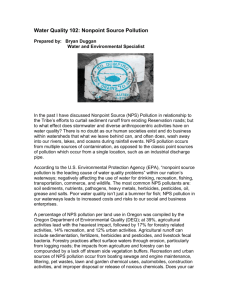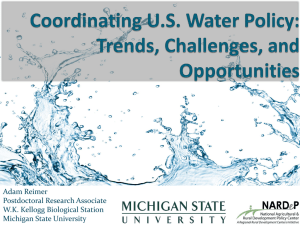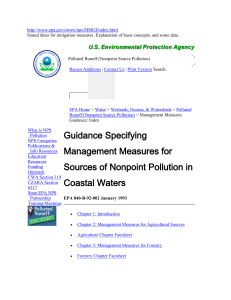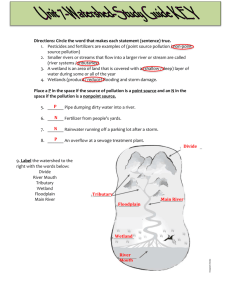Appendix C - ArkansasWater.org
advertisement
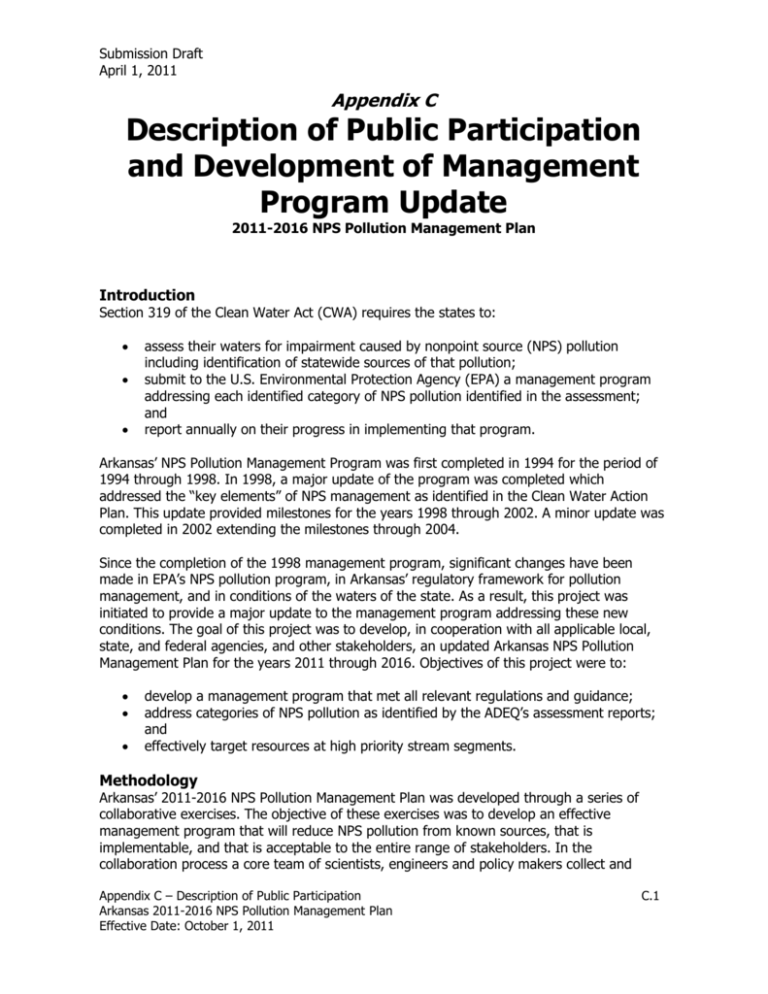
Submission Draft April 1, 2011 Appendix C Description of Public Participation and Development of Management Program Update 2011-2016 NPS Pollution Management Plan Introduction Section 319 of the Clean Water Act (CWA) requires the states to: assess their waters for impairment caused by nonpoint source (NPS) pollution including identification of statewide sources of that pollution; submit to the U.S. Environmental Protection Agency (EPA) a management program addressing each identified category of NPS pollution identified in the assessment; and report annually on their progress in implementing that program. Arkansas’ NPS Pollution Management Program was first completed in 1994 for the period of 1994 through 1998. In 1998, a major update of the program was completed which addressed the “key elements” of NPS management as identified in the Clean Water Action Plan. This update provided milestones for the years 1998 through 2002. A minor update was completed in 2002 extending the milestones through 2004. Since the completion of the 1998 management program, significant changes have been made in EPA’s NPS pollution program, in Arkansas’ regulatory framework for pollution management, and in conditions of the waters of the state. As a result, this project was initiated to provide a major update to the management program addressing these new conditions. The goal of this project was to develop, in cooperation with all applicable local, state, and federal agencies, and other stakeholders, an updated Arkansas NPS Pollution Management Plan for the years 2011 through 2016. Objectives of this project were to: develop a management program that met all relevant regulations and guidance; address categories of NPS pollution as identified by the ADEQ’s assessment reports; and effectively target resources at high priority stream segments. Methodology Arkansas’ 2011-2016 NPS Pollution Management Plan was developed through a series of collaborative exercises. The objective of these exercises was to develop an effective management program that will reduce NPS pollution from known sources, that is implementable, and that is acceptable to the entire range of stakeholders. In the collaboration process a core team of scientists, engineers and policy makers collect and Appendix C – Description of Public Participation Arkansas 2011-2016 NPS Pollution Management Plan Effective Date: October 1, 2011 C.1 Submission Draft April 1, 2011 analyze data and prepare that data for presentation to the stakeholders. The stakeholders then deliberate and interpret the data and in turn provide direction for the core team for further data collection and analysis. Through repeated cycles of the analysis/deliberation process, informed decisions are made that lead to effective and implementable policy. The analysis/deliberation cycle was extended to include an additional step of consultation with individual agencies and interest groups. Thus, the core team was able to learn directly of the special needs of different agencies, professional associations, and interest groups. While no process can meet all of the needs of every interest group, this process provided for input from representatives of the interested parties during the formation of the program. As a result, the recommendations, goals and objectives of this plan represent the collective thought of local, state and federal agencies, agricultural commodity groups, professional associations, environmental organizations, and watershed partnerships. The core team for the collaborative process consisted of scientists and engineers from the Biological and Agricultural Engineering Department (BAEG) at the University of Arkansas, and the University of Arkansas Division of Agriculture Cooperative Extension Service, and the director of Arkansas’ NPS Pollution Management Plan at the Arkansas Natural Resource Commission Arkansas (ANRC). BAEG was responsible for literature reviews, data compilation, geographic information system databases, and water quality modeling. The University of Arkansas Division of Agriculture Cooperative Extension Service provided analysis of policy proposals, input into best management practices (BMPs) and management measures, and assisted with stakeholder meetings. ANRC reviewed all material for conformance with agency policy. To complete the collaborative process, two stakeholder meetings were held. Each meeting had specific goals and objectives to be accomplished. Successive meetings built on information provided by the stakeholders and decisions from the previous meeting (see Table C.1). One-on-one consultations were held between a member or members of the core team and individual interest groups (agencies, professional associations, commodity groups, and environmental groups) between the stakeholder meetings (see Table C.2). Appendix C – Description of Public Participation Arkansas 2011-2016 NPS Pollution Management Plan Effective Date: October 1, 2011 C.2 Submission Draft April 1, 2011 Table C.1: Summary of stakeholder meetings Meeting 1: September 21, 2010 Objectives: Make the stakeholders aware of the current laws, rules, regulations, and policies concerning the NPS Pollution Management Plan. Identify additional sources of data for use in evaluation of specific nonpoint sources of pollution. Identify criteria for prioritizing watersheds for nonpoint source pollution program implementation (see appendix B, Watershed Based Implementation). Preparation: Summarize current state and federal laws, rules, regulations, and policies concerning the NPS pollution program. Summary of current water quality assessment reports and independent water quality research projects. Development of draft watershed prioritization criteria. Results: 72 persons attended. Criteria were selected for use in the qualitative risk assessment watershed prioritization tool. NPS issues related to row crop and livestock agriculture, silviculture, construction, urban, onsite wastewater, resource extraction, and hydromodification were listed. Additional sources of data for watershed assessments were provided. The results of the revised qualitative risk assessment were presented. Subgroups were formed for each of the proposed categories and priority watersheds. For each category and priority watershed, facilitated discussions among the subgroups lead to development of long and short term goals and measurable indicators. Some subgroups were able to develop a set of management measures for implementation over the period of the management program. An additional category for rural roads was proposed. Appendix C – Description of Public Participation Arkansas 2011-2016 NPS Pollution Management Plan Effective Date: October 1, 2011 C.3 Submission Draft April 1, 2011 Meeting 1: September 23, 2011 Objectives: Review results of the watershed prioritization matrix. Develop short and long term goals and objectives for statewide programs and priority watersheds. Review and update plan by priority areas. Preparation: Criteria were entered into the prioritization matrix, based on the criteria eight top priority watersheds were selected for implementation programs. Initial Soil and Water Assessment Tool (SWAT) models were selected for each priority watershed indicating sources of sediment, phosphorus and nitrogen. Other pertinent data were collected for the priority watersheds. Literature reviews of management measures and BMPs were developed for each statewide program. Illustrative goals and measurable indicators were prepared for each category in order to promote discussion. Results: More than 50 persons attended the second meeting also, but not entirely the same group as in the first meeting. The results of the revised qualitative risk assessment were presented. Subgroups were formed for each of the proposed categories and priority watersheds. For each category and priority watershed, facilitated discussions among the subgroups lead to development of long and short term goals and measurable indicators. Some subgroups were able to develop a set of management measures for implementation over the period of the management program. An additional category for rural roads was proposed. Appendix C – Description of Public Participation Arkansas 2011-2016 NPS Pollution Management Plan Effective Date: October 1, 2011 C.4 Submission Draft April 1, 2011 Individual consultations with agencies and interest groups were conducted where it seemed their input was most needed. The initial focus of these meetings was federal agencies that had responsibilities for natural resource management. These meetings provided improved understanding by the core team of what resources are available from these agencies and how those resources could be tapped for the NPS Pollution Management Program. The second focus for the consultations was commodity groups, professional associations, environmental organizations, and watershed groups. Through this series of meetings, the special needs, of these groups were identified along with what resources they could provide to improve implementation of statewide NPS pollution management measures. Finally, the focus turned to the state agencies. These agencies have the ultimate responsibility for implementation of the various statewide elements of the program. Meetings with these agencies provided review of what was and were not applicable policy according to their authorizing legislation. Overall, 23 individual consultations were conducted in preparation of this program. The meetings included several formats from one-on-one consultation with key individuals at the agency to group discussions with the boards of commodity groups and watershed councils. Table C.2: Summary of individual consultations Date Organization Summary January 25, 2010 U of A Division of Agriculture Environmental Task Force Completion and Validation of the SWAT Watershed Model January 28, 2010 U of A Division of Agriculture Environmental Task Force Completion and Validation of the SWAT Watershed Model February 8, 2010 U of A Division of Agriculture Environmental Task Force Completion and Validation of the SWAT Watershed Model February 17, 2010 U of A Division of Agriculture Environmental Task Force Completion and Validation of the SWAT Watershed Model February 24, 2010 U of A Division of Agriculture Environmental Task Force Completion and Validation of the SWAT Watershed Model After completion of the two stakeholder meetings, and all of the individual consultations, a final draft of the management program was compiled with revisions as per the comments provided. This final draft was distributed to the stakeholders for a final review and comment. Revisions to the document were made with respect to the comments as deemed appropriate by the lead agencies. The completed 2011-2016 NPS Pollution Management Plan was then reviewed by ANRC’s attorney and public comments accepted. After consideration of the public comments, the final document was prepared and submitted to EPA Region VI of for Appendix C – Description of Public Participation Arkansas 2011-2016 NPS Pollution Management Plan Effective Date: October 1, 2011 C.5 Submission Draft April 1, 2011 review and approval. Results A total of over 75 persons representing 36 different organizations participated in the development of the NPS Pollution Management Plan through meetings of the NPS Stakeholder Group. Many additional persons were represented in the individual agency consultations and in the Conservation District survey. This stakeholder involvement in collaborative decision making, while it required extensive investment of time and resources provided for comprehensive public participation in the development of the program rather than merely public comment at the end of the process. As a result, the current NPS Pollution Management Program Update should lead to more effective implementation and quicker improvement of the quality of the waters of the state. The final draft of Arkansas’ 2011-2016 NPS Pollution Management Plan has been completed and posted for review by the Nonpoint Source Stakeholder Group. This draft contains the statewide elements of Agriculture, Silviculture, Resource Extraction, Surface Erosion, Road Maintenance and Construction, and Urban Runoff. Priorities selected for implementation during 2005 through 2009 based on the qualitative risk assessment are the Illinois River, Upper White River, L’Anguille River, Lake Conway/Point Remove, Upper Saline River, Bayou Bartholomew, Poteau River, and Little River watersheds. After a period for the NPS Stakeholder Group to review and comment on the final draft, a final document will be prepared and submitted to EPA Region 6 for review. The final document will be completed after EPA’s review of the draft. Comment on the Draft Plan The draft 2011-2016 NPS Pollution Management Plan was posted on the Internet for comment on March 15, 2011. An email was sent to all members of the Stakeholder Group encouraging them to review the draft 2011-2016 Plan and submit comments. Specifically, the plan was outlined and numbered and explicit instructions provided for those comments. Thirty-six comments totaling 49 pages of suggested changes were received. These comments were reviewed and incorporated into the plan that has been submitted to EPA for review and approval. Appendix C – Description of Public Participation Arkansas 2011-2016 NPS Pollution Management Plan Effective Date: October 1, 2011 C.6
